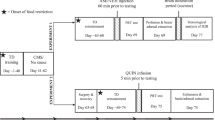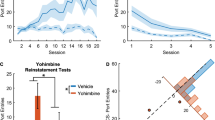Abstract
Chronic exposure to very mild unpredictable stress has previously been found to reduce or abolish the acquisition of place preference conditioning. In the present study, chronic mild stress was found to abolish the acquisition of preferences for a distinctive environment paired with systemic administration of amphetamine (0.5 mg/kg) or quinpirole (100–400 µg/kg) or with quinpirole (0.75 µg) administered bilaterally within the nucleus accumbens. The locomotor stimulant effects of quinpirole (100–400 µg/kg) were also attenuated in stressed animals. The results suggest that decreased sensitivity to reward following chronic mild stress results from a decreased sensitivity of dopamine D2 receptors within the nucleus accumbens.
Similar content being viewed by others
References
Acquas E, Carboni E, Leone P, Di Chiara G (1989) SCH 23390 blocks drug- conditioned place-preference and place-aversion: anhedonia (lack of reward) or apathy (lack of motivation) after dopamine-receptor blockade? Psychopharmacology 99:151–155
American Psychiatric Association (1980) DSM III—Diagnostic and Statistical Manual of Psychiatric Disorders. APA, Washington DC
Anisman H, Zacharko RM (1982) Depression: the predisposing influence of stress. Behav Brain Sci 5:89–137
Aualisi EF, Hoebel BG (1983) Rewarding effects of amphetamine and cocaine in the nucleus accumbens and block by alphaflupenthixol. Soc Neurosci Abstr 9:121
Bardo MT, Neiswander JL, Miller JS (1986) Repeated testing attenuates conditioned place preference with cocaine. Pharmacol Biochem Behav 21:545–549
Bozarth MA (1987) Methods of assessing the reinforcing properties of abused drugs. Springer, Berlin Heidelberg New York
Bozarth MA (1991) The mesolimbic dopamine system as a model reward system. In: Willner P, Scheel-Kruger J (eds) The mesolimbic dopamine system: from motivation to action. Wiley, Chichester, pp 301–330
Brown GW, Harris T (eds) (1988) Life events and illness. Guilford Press, New York
Carr GD, White NM (1983) Conditioned place preference from intra-accumbens but not intra-caudate amphetamine injections. Psychopharmacology 89:340–346
Carr GD, White NM (1986) Anatomical disassociation of amphetamine's rewarding and aversive effects: an intracranial microinjection study. Psychopharmacology 89:340–346
Carr GD, Fibiger HC, Phillips AG (1989) Conditioned place preference as a measure of drug reward. In: Liebman JM, Cooper SJ (eds) The neuropharmacological basis of reward. Oxford University Press, Oxford, pp 264–319
De Cola JP, Rosellini RA, Warren DA (1988) A dissociation of the effects of control and prediction. Learn Motiv 19:269–282
Di Chiara G, Acquas E, Carboni E (1991) Role of mesolimbic dopamine in the motivational effects of drugs: Brain dialysis and place preference studies. In: Willner P, Scheel-Kruger J (eds) The mesolimbic dopamine system: from motivation to action. Wiley, Chichester, pp 365–383
Fawcett J, Clark DC, Scheftner WA, Gibbons RD (1983) Assessing anhedonia in psychiatric patients: The pleasure scale. Arch Gen Psychiatry 40:79–84
Fuller RW, Hemrick-Luecke SK (1985) Decrease in hypothalamic epinephrine concentration and other neurochemical changes produced by quinpirole, a dopamine agonist, in rats. J Neural Transm 61:161–173
Gilbert DB, Dembski JE, Stein L, Belluzi JD (1986) Dopamine and reward: conditioned place preference induced by dopamine D2 receptor agonist. Soc Neurosci Abstr 9:120
Hahn B, Zacharko RM, Anisman H (1986) Alterations of amphetamine elicited perseveration and locomotor excitation following acute and repeated stressor application. Pharmacol Biochem Behav 25:29–33
Herman GP, Stinus L, LeMoal M (1984) Repeated stress increases locomotor response to amphetamine. Psychopharmacology 84:431–435
Hoffman DC, Beninger RJ (1988) Selective D1 and D2 dopamine receptor agonists produce opposing effects in place conditioning but not in conditioned taste aversion. Pharmacol Biochem Behav 31:1–8
Hoffman DC, Dickson PR, Beninger RJ (1988) The dopamine D2 receptor agonists, quinpirole and bromocriptine produce conditioned place preferences. Prog Neuropsychopharmacol Biol Psychiatry 12:315–322
Kanner AD, Coyne JC, Schaefer C, Lazarus RS (1981) Comparison of two modes of stress measurement: Daily hassles and uplifts versus major life events. J Behav Med 4:1–39
Klein DF (1974) Endogenomorphic depression: a conceptual and terminological revision. Arch Gen Psychiatry 31:447–454
Liebman JM, Cooper SJ (1989) The neuropharmacological basis of reward. Oxford University Press, Oxford
Lloyd C (1980) Life events and depressive disorders reviewed 2. Events as precipitating factors. Arch Gen Psychiatry 37:541–548
Minor TR, Pelleymounter MA, Maier SF (1988) Effects of task-irrelevant cues and reinforcement delay on choice-escape learning following inescapable shock: Evidence for a deficit in selective attention. J Psychol Anim Behav Proc 10:543–556
Mithani S, Martin-Iverson MT, Phillips AG, Fibiger HC (1986) The effects of haloperidol on amphetamine- and methylphenidate-induced conditioned place preferences and locomotor activity. Psychopharmacology 90:247–252
Moreau JL, Jenck F, Martin JR, Mortas P, Haefely WE (1992) Antidepressant treatment prevents chronic unpredictable mild stress-induced anhedonia as assessed by ventral tegmental self-stimulation behavior in rats. Eur Neuropsychopharmacol 2:43–49
Muscat R, Willner P (1992) Suppression of sucrose drinking by chronic mild unpredictable stress: a methodological analysis. Neurosci Biobehav Rev (in press)
Muscat R, Towell A, Willner P (1988) Changes in dopamine autoreceptor sensitivity in an animal model of depression. Psychopharmacology 94:545–550
Muscat R, Sampson D, Willner P (1990) Dopaminergic mechanism of imipramine action in an animal model of depression. Biol Psychiatry 28:223–230
Muscat R, Papp M, Willner P (1992) Reversal of stress-induced anhedonia by the atypical antidepressants, fluoxetine and maprotiline. Psychopharmacology (in press)
Nelson JC, Charney DS (1981) The symptoms of major depression. Am J Psychiatry 138:1–13
Papp M, Willner P (1990) 8-OH-DPAT-induced place preference and place aversion: effects of PCPA and dopamine antagonists. Psychopharmacology 103:99–102
Papp M, Willner P, Muscat R (1991) An animal model of anhedonia: attenuation of sucrose consumption and place preference conditioning by chronic unpredictable mild stress Psychopharmacology 104:255–259
Papp M, Lappas S, Muscat R, Willner P (1992) Attenuation of place preference conditioning but not place aversion conditioning by chronic mild stress. J Psychopharmacol 6:352–356
Paxinos G, Watson C (1986) The rat brain in sterotaxic coordinates. Academic Press, Sydney
Pellegrino LJ, Cushman AJ (1967) A stereotaxic atlas of the rat brain. Appleton-Century-Crofts, New York
Pulvirenti L, Swerdlow NR, Hubner CB, Koob GF (1991) The role of limbic-accumbens-pallidal circuitry in the activating and reinforcing properties of psychostimulant drugs. In: Willner P, Scheel-Kruger J (eds) The mesolimbic dopamine system: from motivation to action. Wiley, Chichester, pp 129–138
Robinson TE, Becker JB (1986) Enduring changes in brain and behavior produced by chronic amphetamine administration: a review and evaluation of animal models of amphetamine psychosis. Brain Res Rev 11:157–198
Rosellini RA, De Cola JP, Plonsky M, Warren DA, Stillman AJ (1984) Uncontrollable shock proactively increases sensitivity to response-reinforcer independence in rats. J Exp Psychol [Anim Behav Proc] 10:346–359
Sahakian BJ, Robbins TW, Morgan MJ, Iversen SD (1975) The effects of psychomotor stimulants on stereotyped and locomotor activity in socially deprived and control rats. Brain Res 84:195–205
Sampson D, Muscat R, Willner P (1991) Reversal of antidepressant action by dopamine antagonists in an animal model of depression. Psychopharmacology 104:491–495
Sherman JE, Hickis CF, Rice AG, Rusiniak KW, Garcia J (1983) Preferences and aversions for stimuli paired with ethanol inhungry rats. Anim Learn Behav 11:101–106
Sokoloff P, Giros B, Martres M-P, Bouthenet M-L, Schwartz J-C (1990) Molecular cloning and characterization of a novel dopamine receptor (D3) as a target for neuroleptics. Nature 347:146–151
Spyraki C, Fibiger HC, Phillips AG (1982a) Attenuation by haloperidol of place preference conditioning using food reinforcement. Psychopharmacology 77:379–382
Spyraki C, Fibiger HC, Phillips AG (1982b) Dopaminergic substrates of amphetamine-induced place preference conditioning. Brain Res 253:185–193
Stamford JA, Muscat R, O'Connor JJ, Patel J, Trout SJ, Wieczorek WJ, Kruk ZL, Willner P (1991) Subsensitivity to reward following chronic mild stress is associated with increased release of mesolimbic dopamine. Psychopharmacology 105:275–282
Van der Kooy D, Swerdlow NR, Koob GF (1983) Paradoxical reinforcing properties of apomorphine: effects of nucleus accumbens and area postrema lesions. Brain Res 259:111–118
White NM, Packard MG, Hiroi N (1991) Place conditioning with dopamine D1 and D2 agonists injected peripherally or into the nucleus accumbens. Psychopharmacology 103:271–276
Willner P, Towell A, Sampson D, Muscat R, Sophokleous S (1987) Reduction of sucrose preference by chronic mild stress and its restoration by a tricyclic antidepressant. Psychopharmacology 93:358–364
Willner P, Klimek V, Golembiowska K, Muscat R (1991) Changes in mesolimbic dopamine may explain stress-induced anhedonia. Psychobiology 19:79–84
Wise RA (1982) Neuroleptics and operant behavior: the anhedonia hypothesis. Behav Brain Sci 5:39–87
Zacharko RM, Anisman H (1991) Stressor provoked alterations of intracranial self-stimulation in the mesocorticolimbic dopamine system: an animal model of depresson. In: Willner P, Scheel-Kruger J (eds) The mesolimbic dopamine system: from motivation to action. Wiley, Chichester, pp 409–442
Zacharko RM, Bowers WJ, Kokkinidis L, Anisman H (1983) Region specific reductions of intracranial self-stimulation after uncontrollable stress: possible effects on reward processes. Behav Brain Res 9:129–141
Zacharko RM, Bowers WJ, Anisman H (1984) Responding for brain stimulation: Stress and desmethylimipramine. Prog Neuropsychopharmacol Biol Psychiatry 8:601–606
Author information
Authors and Affiliations
Rights and permissions
About this article
Cite this article
Papp, M., Muscat, R. & Willner, P. Subsensitivity to rewarding and locomotor stimulant effects of a dopamine agonist following chronic mild stress. Psychopharmacology 110, 152–158 (1993). https://doi.org/10.1007/BF02246965
Received:
Revised:
Issue Date:
DOI: https://doi.org/10.1007/BF02246965




